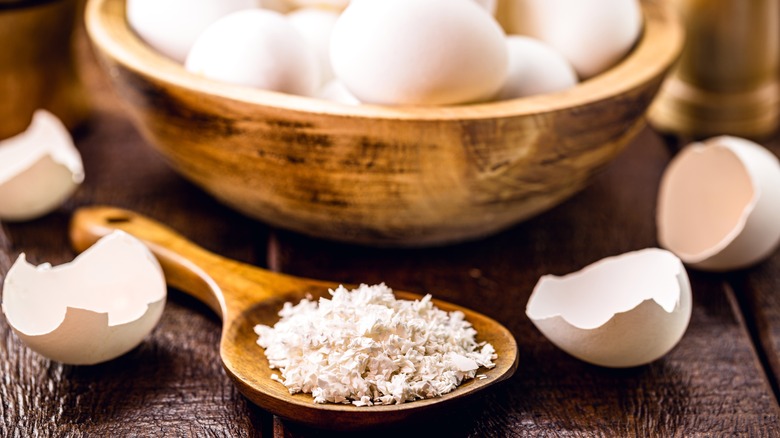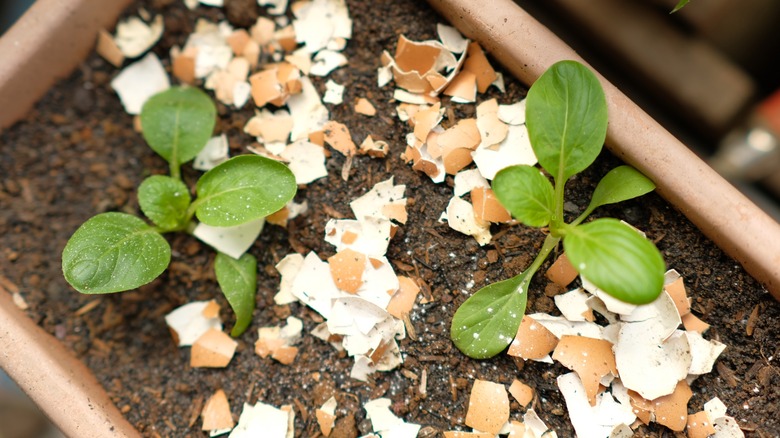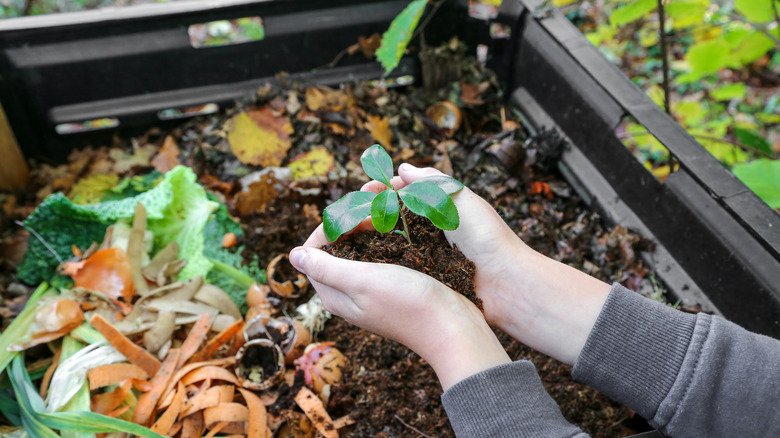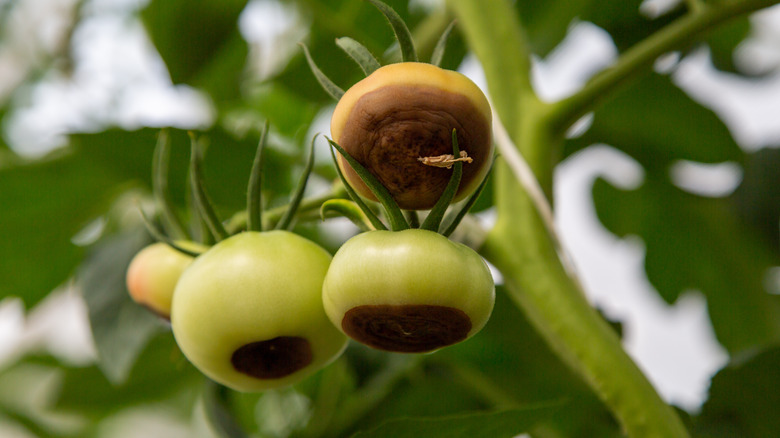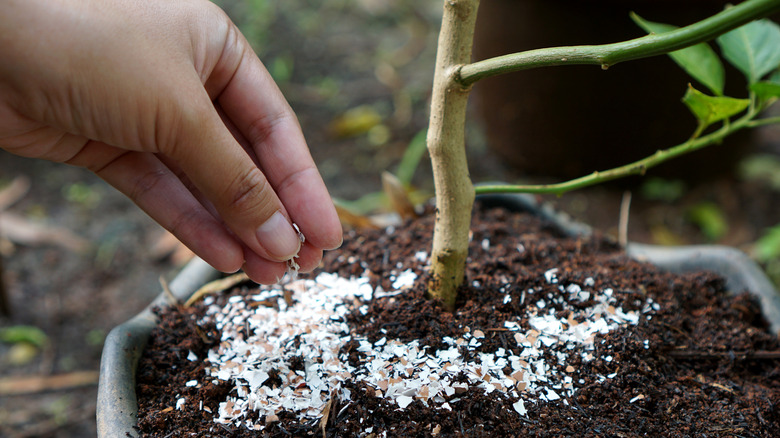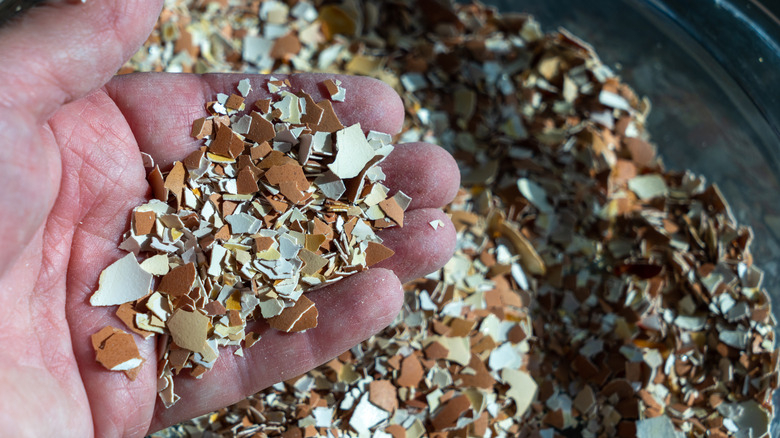5 Expert Ways To Use Eggs In Your Garden
Eggs are simply delicious, whether scrambled, fried, on a sandwich, in an omelet, or whipped into a batter for an amazing cake. If you are any level of home chef or foodie, you probably go through tons of eggs. Although using raw eggshells as fertilizer may not be the ideal approach to providing your plants with calcium, the shells are a proven winner in the garden. If you are just throwing the eggshells out when you are done cracking your eggs open, you are missing out on a valuable resource that could help your plants thrive. It's true — eggshells are beneficial for plant growth in a number of ways, as Los Angeles Times reports.
Upcycling this outer layer for use in your garden or on your houseplants is a great way to reduce waste and do your part in the fight against climate change as well. Eggshells and other food waste decompose differently when it is sent to the landfill, according to Honestly Modern, which also notes that dumping grounds are an enormous source of methane, a greenhouse gas that is eating away at the Earth's atmosphere and the ozone layer. So don't throw those shells out — make sure you incorporate them into your garden fertilization plans to keep your waste out of the landfill and make your plants happier and more productive. It's a win all around.
1. Use eggshells for a calcium boost
Eggshells are made almost entirely of calcium carbonate, meaning they are a great option for adding a shot of much-needed calcium to your plant's soil, according to the Los Angeles Times. This boost is significant for food-growing plants high in calcium, so an eggshell fertilizer can be particularly beneficial for cultivars such as tomatoes, peppers, and eggplants. In addition, leafy greens are also high in calcium, meaning that if you are growing Swiss chard, spinach, or amaranth, adding your eggs' outer layer to your plant's soil can make a big difference. And this isn't the only benefit you can receive from these peels — while calcium is the main component within the shell, eggshells also contain phosphorus and potassium, which can be quite helpful for enhancing plant growth.
To add this fertilizer to your soil, simply keep the shells after you are done making a delicious omelet and crush them up with your fingers (if you rinse the shells out first, make sure you are only rinsing out leftover egg white, not the shell's membrane, which also contains valuable nutrients). Then, mix the crushed shells directly into the soil or fertilizer you plan to apply to your plants. Remember that eggshells take a long time to decompose, so if you add them to your soil or fertilizer now, you shouldn't expect them to impact this year's plants. By the time they break down, they will be an excellent calcium addition for next year's crop!
2. Use eggshells to make compost
You may have heard the phrase "black gold" to describe the value of oil, but in a gardener's world, the real black gold is DIY compost. Compost is a type of garden additive that is jam-packed with vital nutrients that encourage all kinds of spectacular plant growth. You can buy it in gardening stores (spoiler alert: it can be pretty expensive), but there is no need to spend money on something you can easily make yourself at home. Compost is so nutrient-dense because it is made by processing food scraps, usually via worms, bacteria, and various fungi, as Honestly Modern reports. This all-natural process is cheap and easy because all you need to get started is the food waste from your kitchen that you were probably just going to throw out anyway. And yes, that includes your eggshells.
According to the Michigan State University Extension, eggshells are a great addition to your home compost pile. However, as mentioned above, they do take a long time to break down completely, and some people are not fans of visible white peels in their finished compost product, so if you prefer a darker, more uniform fertilizer, you may want to thoroughly dry out them before composting them, which will help them to break down faster. But regardless of how you choose to compost your shells, they are an excellent source of nutrients and will help balance out your final compost product.
3. Use eggshells to (partially) prevent blossom end rot
Blossom end rot is one of the most frustrating issues to experience as a vegetable gardener. Your plants are cruising along, flowering, and starting to produce tasty-looking fruit when BAM! Your beautiful tomatoes, peppers, and other goodies start shriveling up from the bottom. Blossom end rot is incredibly common and is technically caused by a calcium deficiency, as reported by the Mississippi State University Extension. You may be thinking, "Okay, if my plants need calcium and eggshells provide a ton of calcium, then adding the egg peels to my plant soil must be all I need to do, right?" Not so fast. The true culprit in instances of blossom end rot is often an inconsistent watering schedule. You can put tons of eggshells into the soil, but if there's not enough moisture for the plant to consistently draw the nutrients in the soil in and upwards, the peels are essentially useless.
That being said, if you are on a consistent watering schedule, eggshells can definitely help address calcium deficiencies. Mississippi State University Extension recommends taking a soil sample from your garden and testing it for calcium content (and other nutrients, too, while you're at it). If you see that the levels are low, and your tomatoes and other fruits are still struggling with blossom end rot even while on a consistent watering schedule, then it may be time to bring in the big guns: eggshells.
4. Use eggshells to deter pests
If you have used another calcium additive in your potting mix and your plants are happy and thriving, you can still use eggshells in your garden, as they are an excellent weapon in the war on common garden pests. Eggshells are a natural deterrent to ground-bound insect pests that cannot fly; some common examples include snails, slugs, cutworms, earwigs, cabbage looper caterpillars, pickle worms, gypsy moth larvae, and tomato hornworms, according to research from the University of Wisconsin-Madison. To prevent these insects from crawling up the stalks of your plants and wreaking havoc on their leaves and fruits, the Los Angeles Times recommends using eggshells to build a barrier around the base of your plant.
If you break up the peels into shards and spread them in an area about 2 inches wide that surrounds where your plant's stalk touches the soil, the sharp edges of the shards will repel the bugs and prevent them from getting close enough to your plant to do damage. It may also encourage the pests to move on from your garden entirely, as they cannot find a food source and may need to seek greener pastures. Eggshells are a much more benevolent pest repellent than chemical compounds, which often harm beneficial insects and plants as well and can do long-term environmental damage to the climate.
5. Make eggshell tea for indoor plants
What if you do not have the space or the yard access for an outdoor garden? Never fear; you can still utilize the magic of eggshells for your indoor houseplants. Just brew up a concoction known as "eggshell tea" using a recipe from the Los Angeles Times. When you're done cooking with your eggs, rinse all of the remaining sticky whites and yolks out of your shells. Dry them out, either by sticking them in the corner of your microwave while you heat up other food or tucking them away in your fridge (or on your counter if you live in an area without a lot of humidity). Next, crumble up your dried-out shells and pour boiling water over them. Allow them to steep until the boiling water cools to room temperature.
If you want to reap the full benefits of this fertilizer, you can pour the whole concoction directly onto your houseplants' soil exactly how you would normally water them. If you are not the biggest fan of the aesthetics of eggshells in your plants' soil, you can strain them out and simply pour over the steeped water. Enough of the eggshell nutrients will have permeated the water so that it will still provide a fertilizing boost. Just keep in mind that decorative plants do not need as much calcium as plants that produce food, so refrain from watering your succulent collection with this concoction.
